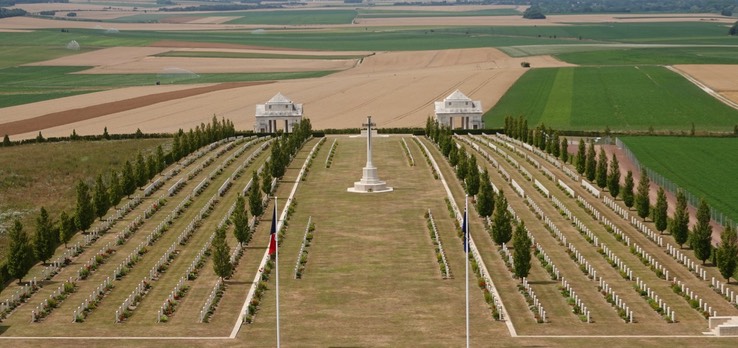 As usual we took a wrong turn on our way from the Grand-Large yacht club to the city of Mons. It extended the three kilometre cycle to five and had me struggling up the steep cobblestone streets to the top of the old town!
As usual we took a wrong turn on our way from the Grand-Large yacht club to the city of Mons. It extended the three kilometre cycle to five and had me struggling up the steep cobblestone streets to the top of the old town! 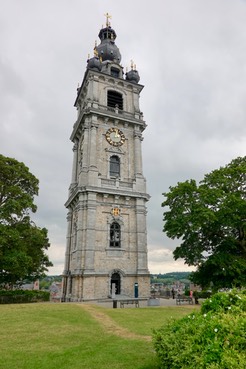
As the name “Mons” (mountain) indicates, it is built on a hill crowned by the heritage listed 87m high Belfry Tower, the only baroque style “Beffroi” in Belgium. From its top a great view over the town and surrounds can be enjoyed. Not much evidence of the old coal mining days of the 60s is visible, although further out in Mons- Borinage a couple of coal mining sites remained. It is there that the great van Gogh lived among the miners and underwent the transition from preacher to artist.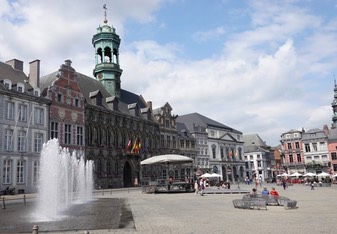
From the highest point of town the cobbled streets descend to the “Grand-Place”. It really is a “grand” place! The beautiful 15th century facade of the town hall giving it some special significance. A little cast iron statue of a monkey right next to the main entrance comes as a surprise! It has a very shiny head, because local legend suggests that stroking its head with the left hand brings 1 year good luck.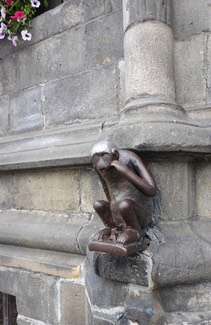 And as nobody really knows the reason for the monkey being there, we were happy to go along with that - just in case!
And as nobody really knows the reason for the monkey being there, we were happy to go along with that - just in case! 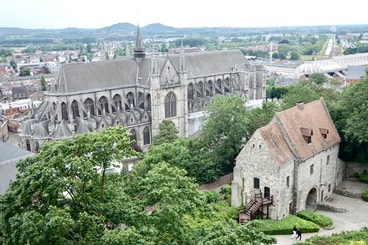
Walking downhill on the other side one cannot miss the early 16th century Collegiate Church of Saint Waudru and the surrounding convent buildings. Saint Waudru, also called Waltrude in other regions, was married to a count and had 4 children before founding her own convent. The city grew around it and Saint Waudru became the patron saint of Mons.
Every year on the Sunday after Whitsunday as part of the holy trinity procession, a gilded horse drawn cart carrying Saint Waudru's shrine is driven through the city. For the last steep hill the locals traditionally gather behind the carriage and help pushing it up. The rest of the year the “car d’or” with its buxom cherubs lives in the church.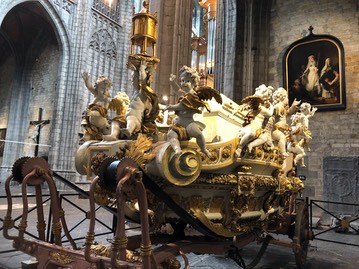
The following day we got our own little carriage, not quite golden but good enough for us two rotund cherubs to travel to the Somme. Our eating habits have been quite bad over the last two months to the stage where I now could write my very own “Bridget Jones’ Diary “. Not altogether our fault though! For example, we ordered what sounded like a smallish lunch a “French Taco”. What arrived was a huge wrap filled with chicken and chips smothered with melted cheese, then topped with a relish and more cheese! No greens were harmed in making it!
We knew that visiting our friends Jan and Bill, who invited us to stay on their boat, wouldn’t be a time to start our diet. They had set aside a home made bottle of Sloe-gin for Austin and Jan made one of her lovely 3 course dinners. The problem was that we had indulge already on the way to the Somme when we stopped in Péronne to catch up with Aileen and Grahame. The “cuppa” we were supposed to pop in for was accompanied by all sorts of delicacies. Enough about food! It is always fun to spent time with the lovely couple from across”the ditch”.
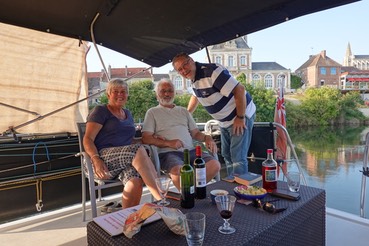
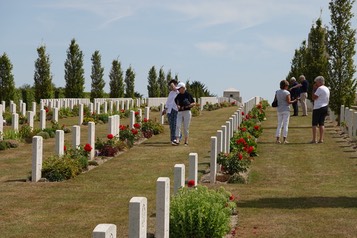
We had really looked forward to seeing our Toul buddies, and it was great when we finally did! Jan and Bill had “parked” La Bonne Vie at the most picturesque spot in Long on the Somme. It was a fabulous night of talking, eating, drinking and playing cards. Unfortunately Bill wasn’t a good enough host to let us win. But we’ll forgive him.
On Jan’s suggestion, we drove the next day to the Australian War Memorial and Sir John Monash Centre at Fouilloy on the Route de Villers Bretonneux. We concurred with our friends that it is unbelievable such war horrors have played out in the idyllic, rural landscape. The memorial is set on a hill and beautifully landscaped. Shocking are the many unnamed graves and inscription like: "believed to be buried here”.
The Museum is named after Australia’s most well known general and commander of WWI troops, John Monash, who was born in Melbourne to a Prussian Jewish family. His troops were involved in many battles and helped in 1918 to stem the German offensive. Visitors of the centre are taken through Australias involvement in WWI, from the initial decision to join the war effort to the terrible aftermath: the incredible losses, injuries and long-term psychological illnesses. The audio-visual tour is more than touching and it was comforting to come back to Jan and Bill’s boat and relax for a while.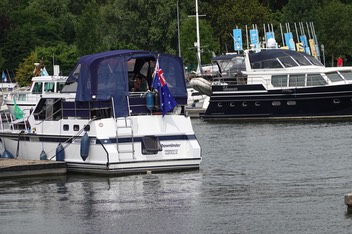
We arrived back quite late at the yacht club of Mons and - who should be moored there!? But the “Downunder” with Anne and Gordon! Another newly arrived Australian boat had also joined the Aussie invasion! To quote Sir John Monash: “…… to advance under maximum possible protection,….” I think we Aussies have mastered that!
More about the Aussies in the next blog!